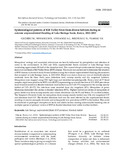| dc.contributor.author | Gicheru, M | |
| dc.contributor.author | Mwangi, Benson | |
| dc.contributor.author | Onyango, A I | |
| dc.contributor.author | Michuki, G N | |
| dc.contributor.author | Kamau, S K | |
| dc.date.accessioned | 2022-03-03T07:08:35Z | |
| dc.date.available | 2022-03-03T07:08:35Z | |
| dc.date.issued | 2021 | |
| dc.identifier.citation | Kamau et al., (2021). Epidemiological patterns of Rift Valley Fever from diverse habitats during an extreme unprecedented flooding of Lake Baringo basin, Kenya, 2012-2013. East African Journal of Science, Technology and Innovation 2(3). | en_US |
| dc.identifier.issn | 2707-0425 | |
| dc.identifier.uri | http://hdl.handle.net/123456789/5522 | |
| dc.description.abstract | Mosquitoes’ ecology and associated arboviruses are heavily influenced by precipitation and retention of
water in the environment. In 2011 and 2014, unprecedented floods occurred in Lake Baringo basin
inundating approximate 88 km2 of the shoreline land. This caused abrupt environmental changes raising
fears of an outbreak of Rift Valley Fever (RVF) disease. This study was carried out to determine the situation
of RVF disease in livestock from diverse habitats during the extreme unprecedented flooding phenomenon
that occurred in Lake Baringo basin, in 2012-2013. Blood was drawn from ear vein of livestock selected
randomly from the three study areas (lakeshore land, swamp marshy and dry rangeland habitats).
Mosquitoes were trapped using CDC light traps and identified morphologically. From a total of 77 blood
samples, eight were positive for RVF virus (RVFV) representing an overall infection of 12%. RVF prevalence
from livestock resident in flooded lakeshore land habitat was 2.6% (N=77) compared to the swamp marshy
habitat at 7.8% (N=77). No infections were recorded from dry rangeland (0%). Mosquitoes of genus
Mansonia dominated the catches in flooded lakeshore (98%). Highest individual catches of mosquitoes of
genus Aedes was from swamp marshy area whose abundance was 96.8% and below 2% in other habitats.
The Simpson’s Diversity Index for mosquitoes from swamp marshy habitat was 0.56, dry rangeland 0.57
and lakeshore land 0.13. The flooded lakeshore land was the most affected by the unprecedented floods
resulting in uneven mosquito diversity and subsequently low prevalence of RVF in this habitat. This could
be attributed to prolonged disruption of biotic and abiotic factors creating unfavourable breeding sites of
multiple species of primary vectors of RVF in flooded lakeshore land unlike in other habitats. | en_US |
| dc.language.iso | en | en_US |
| dc.publisher | East African Journal of Science, Technology and Innovation, Vol. 2 (3): June 2021 | en_US |
| dc.subject | Lake Baringo; unprecedented floods; RVF prevalence; livestock; habitat | en_US |
| dc.title | Epidemiological patterns of Rift Valley Fever from diverse habitats during an extreme unprecedented flooding of Lake Baringo basin, Kenya, 2012-2013 | en_US |
| dc.type | Article | en_US |

